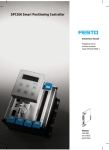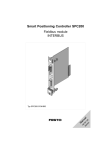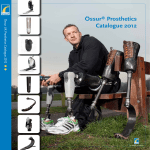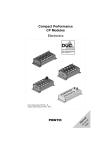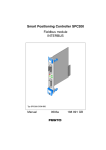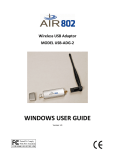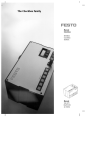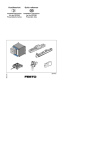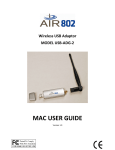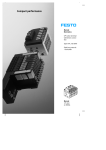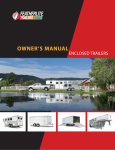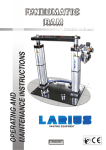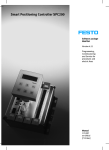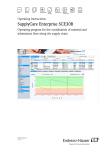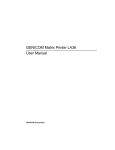Download Smart Positioning Controller SPC200 Stepping motor
Transcript
Smart Positioning Controller SPC200 Stepping motor indexer module Type SPC200-SMX-1 Author: Editors: Layout: Type setting: P. Mauch H.-J. Drung, M. Holder Festo AG & Co., Dept. KI-TD KI-TD Printed on 100 % recycled paper Edition: 9904NH SPC200-SMX-1 9904NH (Festo AG & Co., D-73726 Esslingen, Federal Republic of Germany, 1999) The copying, distribution and utilization of this document as well as the communication of its contents to others without expressed authorization is prohibited. Offenders will be held liable for the payment of damages. All rights reserved, in particular the right to carry out patent, utility model or ornamental design registration. I Order no.: Description: Designation: II 188 895 Manual P.BE-SPC200-SMX-1-GB SPC200-SMX-1 9904NH Contents Designated use. . . . . . . . . . . . . . . . . . . . . . . . . . . . . . . . . . . . . . . . . . . . . . V Target group . . . . . . . . . . . . . . . . . . . . . . . . . . . . . . . . . . . . . . . . . . . . . . . VI Important user instructions . . . . . . . . . . . . . . . . . . . . . . . . . . . . . . . . . . . VII Danger categories . . . . . . . . . . . . . . . . . . . . . . . . . . . . . . . . . . . . . . . . . . VII Notes on this manual . . . . . . . . . . . . . . . . . . . . . . . . . . . . . . . . . . . . . . . IX Product-specific terms and abbreviations . . . . . . . . . . . . . . . . . . . . . . . . . X 1. System summary 1.1 1.2 1.2.1 1.3 1.3.1 1.4 1.5 1.6 System structure . . . . . . . . . . . . . . . . . . . . . . . . . . . . . . . . . . . . . 1-3 Basic equipment for operating a stepping motor axis . . . . . . . . . 1-4 Connecting and display elements of the stepping motor indexer module . . . . . . . . . . . . . . . . . . . . . . . . . . 1-7 Drive packages. . . . . . . . . . . . . . . . . . . . . . . . . . . . . . . . . . . . . . . 1-8 Power controller . . . . . . . . . . . . . . . . . . . . . . . . . . . . . . . . . . . . . 1-8 Electromechanical linear drive . . . . . . . . . . . . . . . . . . . . . . . . . . 1-11 Accessories . . . . . . . . . . . . . . . . . . . . . . . . . . . . . . . . . . . . . . . . 1-11 EMERGENCY STOP concept . . . . . . . . . . . . . . . . . . . . . . . . . . 1-12 2. Fitting 2.1 2.2 Fitting and removing the stepping motor indexer module . . . . . . 2-4 Fitting the electric axis and the power controller . . . . . . . . . . . . . 2-7 3. Installation 3.1 3.2 3.3 3.4 General instructions . . . . . . . . . . . . . . . . . . . . . . . . . . . . . . . . . . . 3-3 Connecting the sensors . . . . . . . . . . . . . . . . . . . . . . . . . . . . . . . . 3-6 Connecting the power controller and the stepping motor . . . . . . 3-9 Connecting the control cable . . . . . . . . . . . . . . . . . . . . . . . . . . . . 3-9 SPC200-SMX-1 9904NH III 4. Commissioning 4.1 4.2 4.3 4.3.1 4.3.2 4.3.3 4.3.4 4.4 4.4.1 4.4.2 4.5 4.6 Procedure for commissioning . . . . . . . . . . . . . . . . . . . . . . . . . . . 4-3 Preparations for commissioning . . . . . . . . . . . . . . . . . . . . . . . . . 4-4 Commissioning with WinPISA . . . . . . . . . . . . . . . . . . . . . . . . . . 4-7 Configuration of the axis parameters . . . . . . . . . . . . . . . . . . . . . 4-8 Configuration of the application parameters . . . . . . . . . . . . . . 4-10 Loading the axis configuration into the SPC200 . . . . . . . . . . . 4-17 Functional test of the stepping motor axes . . . . . . . . . . . . . . . 4-18 Commissioning with the operating panel . . . . . . . . . . . . . . . . . 4-22 Setting the project-specific parameters . . . . . . . . . . . . . . . . . . 4-23 Functional test of the stepping motor axes . . . . . . . . . . . . . . . 4-25 Example of program . . . . . . . . . . . . . . . . . . . . . . . . . . . . . . . . . 4-29 Notes on operation . . . . . . . . . . . . . . . . . . . . . . . . . . . . . . . . . . 4-30 5. Diagnosis and error treatment 5.1 5.2 5.3 5.4 5.5 General instructions on diagnosis . . . . . . . . . . . . . . . . . . . . . . . On-the-spot diagnosis. . . . . . . . . . . . . . . . . . . . . . . . . . . . . . . . . Diagnosis with the WinPISA. . . . . . . . . . . . . . . . . . . . . . . . . . . . Diagnosis with the operating panel . . . . . . . . . . . . . . . . . . . . . . Emergency travel . . . . . . . . . . . . . . . . . . . . . . . . . . . . . . . . . . . . 5-3 5-4 5-5 5-7 5-8 A. Technical specifications A.1 A.2 A.3 IV Technical specifications . . . . . . . . . . . . . . . . . . . . . . . . . . . . . . . A-3 Internal circuitry . . . . . . . . . . . . . . . . . . . . . . . . . . . . . . . . . . . . . A-4 Index . . . . . . . . . . . . . . . . . . . . . . . . . . . . . . . . . . . . . . . . . . . . . . A-6 SPC200-SMX-1 9904NH Designated use The stepping motor index module type SPC200-SMX-1 has been designed for connecting a suitable stepping motor power controller to the SPC200. With this power controller, the SPC200 can control a stepping motor axis. Maximum three stepping motor index modules can be installed in a rack. The basic components and modules for the SPC200 are described in the User Manual type P.BE-SPC200-... You must observe at all costs the safety precautions described therein as well as the designated use of the individual components and modules. Please observe also the notes on safety in the operating instructions for the components used. The SPC200 as well as the modules and cables to be connected may only be used as follows: – as intended – in their original state – without any modifications – in perfect technical condition If used with additional commercially-available components, such as sensors and actuators, the specified limits for pressures, temperatures, electrical specifications, torques, etc. must be observed. Local and national technical regulations must also be observed. SPC200-SMX-1 9904NH V Target group This manual is directed exclusively at technicians trained in control and automation technology and who have experience in installing, commissioning, programming and diagnosing stepping motor axes. VI SPC200-SMX-1 9904NH Important user instructions This manual contains instructions on possible dangers which can occur if the SPC200 is not used correctly. These instructions are printed in italics, are placed in a frame and also marked with a pictogram. Danger categories A distinction is made beween the following: WARNING: This means that considerable injury to people and/or damage to property can occur if these instructions are not observed. CAUTION: This means that injury to people and/or damage to property can occur if these instructions are not observed. PLEASE NOTE: This means that damage to property can occur if these instructions are not observed. SPC200-SMX-1 9904NH VII Pictograms Pictograms and symbols supplement the danger instructions and Draw attention to the nature and consequences of dangers. The following pictograms are used: Uncontolled movements of loose tubing Unintentional movements of the connected actuators High electric voltage or undefined switching status of the electronic components which consequently affect connected circuits. Electrostatically vulnerable components which will be damaged if the contacts are touched. Recommendations and tips are marked with this pictogram. Text markings • This point marks activities which can be carried out in any order. 1. Numbers denote activites which must be carried out in the sequence listed. – Hyphens denote general activities. VIII SPC200-SMX-1 9904NH Notes on this manual This manual contains general basic information on fitting as well as installing and commissioning the SPC200 as a stepping motor controller. Reference is made to the SPC200 Smart Positioning Controller with operating system version V 3.x and with WinPISA as from version 3.x. Manuals on the SPC200 Smart Positioning Controller Type Name Contents System manual SPC200 Smart Positioning Controller, manual type P.BE-SPC200-.. Installation, commissioning and diagnosis with the SPC200; standard components and modules Software manual Software package WinPISA type P.SW-WIN-PISA-.. Functions of the WinPISA software package Help system Help system for WinPISA contained in WinPISA) WinPISA help system Manuals Field bus module type P.BE-SPC200-COM-.. Installation, commissioning and diagnosis of the relevant field bus module Stepping motor indexer module type P.BE-SPC200-SMX-1-.. Installation, commissioning and diagnosis when using a stepping motor Electrical positioning system type P.BE-ATP-.. Further information on electrical positioning systems Special information on commissioning, programming and diagnosing the SPC200 with the WinPISA software package can be found in the relevant manual for WinPISA. Information on the electric axes, drive packages and sensors can be found in the documentation supplied with the product. SPC200-SMX-1 9904NH IX Product-specific terms and abbreviations The following product-specific terms and abbreviations are used in this manual: Term/abbreviation Meaning Drive package Power controller with stepping motor, if necessary with gears Modules Plug-in cards which must be inserted in the rack of the SPC200. I/Os Digital inputs and outputs Electric axis Combination of motor, coupling (coupling housing with coupling and flange), electromechanical linear axis, as well as the necessary cables and sensors Electromechanical Linear drive Linear guide with spindle or toothed-belt drive I Digital input Q Digital output Record selection mode Operating mode of the SPC200 which supports close coupling with a higher-order PLC/IPC. Start/stop mode Operating mode of the SPC200 which supports both autonomous operation and control by a higher-order PLC/IPC. X SPC200-SMX-1 9904NH 1. System summary Chapter 1 System summary SPC200-SMX-1 9904NH 1-1 1. System summary Contents 1. System summary 1.1 1.2 1.2.1 1.3 1.3.1 1.4 1.5 1.6 1-2 System structure. . . . . . . . . . . . . . . . . . . . . . . . . . . . . . . . . . . . . 1-3 Basic equipment for operating a stepping motor axis . . . . . . . . 1-4 Connecting and display elements of the stepping motor indexer module . . . . . . . . . . . . . . . . . . . . . . . . . 1-7 Drive packages . . . . . . . . . . . . . . . . . . . . . . . . . . . . . . . . . . . . . . 1-8 Power controller . . . . . . . . . . . . . . . . . . . . . . . . . . . . . . . . . . . . . 1-8 Electromechanical linear drive . . . . . . . . . . . . . . . . . . . . . . . . . 1-11 Accessories. . . . . . . . . . . . . . . . . . . . . . . . . . . . . . . . . . . . . . . . 1-11 EMERGENCY STOP concept . . . . . . . . . . . . . . . . . . . . . . . . . 1-12 SPC200-SMX-1 9904NH 1. System summary 1.1 System structure Stepping motor drives can be coupled to the SPC200 by means of special stepping motor indexer modules. Each stepping motor indexer module type SPC200-SMX-1 enables one stepping motor axis to be coupled. 1 9 2 3 8 7 6 1 2 3 4 5 Programmer/PC for commissioning SPC200 with stepping motor indexer module Power controller Switching cabinet Electromechanical linear drive 5 6 7 8 9 4 Reference/limit switch Coupling and flange Motor, if necessary with gears Pneumatic axis (optional) Bild 1/1: System summary SPC200-SMX-1 9904NH 1-3 1. System summary 1.2 Basic equipment for operating a stepping motor axis Equipped with the following modules, the SPC200 is already a functionable controller for coupling to a stepping motor. 1 1 2 3 4 2 3 4 Power supply module Diagnostic module I/O module (optional field bus module) Stepping motor indexer module Fig. 1/2: Basic equipment for operating a stepping motor axis 1-4 SPC200-SMX-1 9904NH 1. System summary Module Description Power supply module Enables the power supply and the axis interface functioning as a field device to be connected Diagnostic module Enables the operating panel to be inserted and a PC to be connected I/O module or field bus module Enables control via I/Os or communication via the field bus Stepping motor indexer module Enables a power controller for a stepping motor to be connected A system equipped with the modules shown above offers the following scope of performance: – control of up to two pneumatic axes – control of a stepping motor axis – programming and diagnosis via a PC or an operating panel – coordination via I/Os or a field bus Providing there are enough empty slots, up to 3 stepping motor indexer modules for controlling 3 electric axes can be fitted in the SPC200. The SPC200 can be controlled via I/Os or via a field bus in the "Start/Stop" or "Recordselection" mode. The I/O module or the field bus module provides the necessary address space here. SPC200-SMX-1 9904NH 1-5 1. System summary For coupling a stepping motor axis to the SPC200 you will require the following components: – the SPC200 Smart Positioning Controller with stepping motor module type SPC200-SMX-1 – the control cable from the SPC200 to the power controller e.g. for Festo drive packages type KSMX-SM5-... – a stepping motor drive package from Festo, consisting of power controller, stepping motor and, if necessary, gears. Other power controllers can be used, providing the connections are compatible. – a net filter, fuse etc. for the power controller – a motor cable for connecting the power controller and stepping motor – a motor flange and coupling – a linear drive (e.g. DGE(L)-...), with accessories – suitable sensors for the reference and limit switches. When selecting sensors, check that the accuracy of the switching point of the sensors determines the accuracy of the refereence point. Make sure that the switching point always lies within a step resolution. 1-6 SPC200-SMX-1 9904NH 1. System summary 1.2.1 Connecting and display elements of the stepping motor indexer module The diagram below shows the connecting and display elements of the stepping motor indexer module type SPC200-SMX-1. 1 2 3 4 1 2 3 4 Control plug (AMPLIFIER, X30), 15-pin ERROR LED (red) STATUS LED (green) Sensor plug (SIGNALS, X31) Fig. 1/3: Connecting and display elements SPC200-SMX-1 9904NH 1-7 1. System summary 1.3 Drive packages Drive packages from Festo are offered for electric axes. These packages consist of: – power controller – stepping motor (if necessary with brake) – gears (if required) The drive package must be suited to the demands of the positioning system (moveable mass, positioning time, etc.), as well as to the electromechanical axis used. A power controller with a 5 V signal level must be used for operating the SPC200 (see technical specifications). 1.3.1 Power controller The power controller is a link between the SPC200 as position controller and a stepping motor. The signals from the position controller are converted by the power controller according to the settings which are dependent on the motor and drive (e.g. phase current). 1-8 SPC200-SMX-1 9904NH 1. System summary 1 2 3 Control signals (PULSE, DIRECT., ENABLE, F/H STEP) READY 1 2 3 SPC200 (position controller) Power controller Stepping motor Fig. 1/4: Control connection for the power controller The control connection of the stepping motor indexer module type SPC200-SMX-1 has been optimized for the power controllers offered with the Festo drive packages. Other power controllers can be used providing the necessary inputs and outputs are compatible with the control output of the stepping motor indexer module (AMPLIFIER connection, see technical specifications). SPC200-SMX-1 9904NH 1-9 1. System summary The stepping motor indexer module has the following inputs and outputs for connecting a power controller: Outputs (RS 485, push-pull control): – PULSE – DIRECT (direction) – ENABLE – F/H STEP (full/half step) Input (relay contact in the power controller): – READY 1-10 SPC200-SMX-1 9904NH 1. System summary 1.4 Electromechanical linear drive Linear drives are used for the electric axes. These convert the rotary movement of the stepping motor into a liner movement of the slide. If the linear drives do not have an integrated guide, an additional guide must be provided. Two types of linear drive are available: – axes with spindle drive DGE(L)-...-SP – axes with toothed-belt drive DGE(L)-...-ZR PLEASE NOTE The maximum length of the linear drives is limited for technical reasons. As from a certain length, spindle drives may therefore only be operated at a limited speed, and toothed-belt drives may only be operated with limited torque. 1.5 Accessories For these positioning systems, Festo offers appropriate accessories which are suited to the drive packages and linear drives (see Festo sales program or catalogue). SPC200-SMX-1 9904NH 1-11 1. System summary 1.6 EMERGENCY STOP concept PLEASE NOTE Check your EMERGENCY STOP concept to see which measures are necessary for placing your machine/system in a safe state in the event of an EMERGENCY STOP (e.g. switching off the load voltage, compressed air). The status of the limit switches connected to the sensor plug will be evaluated by the operating system of the SPC200. WARNING The limit switches connected to the sensor plug are not suitable for implementing an EMERGENCY STOP function. If your application demands an appropriate EMERGENCY STOP circuit, use additional separate safety limit switches. 1-12 SPC200-SMX-1 9904NH 2. Fitting Chapter 2 Fitting SPC200-SMX-1 9904NH 2-1 2. Fitting Contents 2. Fitting 2.1 2.2 Fitting and removing the stepping motor indexer module . . . . . 2-4 Fitting the electric axis and the power controller . . . . . . . . . . . . 2-7 2-2 SPC200-SMX-1 9904NH 2. Fitting WARNING Before undertaking all fitting and maintenance work, switch off the following power supplies in the sequence stated: 1. the compressed air supply 2. all load and operating voltage supplies on the SPC200 and on connected components of the positioning system. You will thereby avoid: – undesired movements of the connected actuators – uncontrolled movements of loose tubing – undefined switching states. SPC200-SMX-1 9904NH 2-3 2. Fitting 2.1 Fitting and removing the stepping motor indexer module CAUTION Incorrect handling can cause damage to the modules. Do not touch the contact surfaces of the modules. Please observe the regulations for handling electrostatically vulnerable components. Discharge yourself electrostatically before fitting or removing components, in order to protect the components from discharges of static electricity. Please note when fitting the module: – The stepping motor indexer module can be fitted as desired in slots 2 to 6. Individual identification of all the fitted modules is carried out automatically. – The axis identifiers are assigned to the modules or connected axes in ascending order without gaps from left to right. – Maximum 3 stepping motor indexer modules can be fitted. – If the stepping motor indexer module is fitted directly next to the diagnostic module, it will not be possible to plug in an operating panel because of the plug of the cable for the power controller. The modules are fastened to the rack with the aid of safety catches. A tool is not therefore required for fitting and removing the modules. 2-4 SPC200-SMX-1 9904NH 2. Fitting WARNING Actuators can be actuated unintentionally and the SPC200 damaged if modules are added or removed when the power supply is switched on. Before undertaking all fitting and maintenance work, switch off the following power supplies in the sequence stated: 1. the compressed air supply 2. all the load and operating voltage supplies on the SPC200 and on connected components of the positioning system. Fitting modules Proceed as follows when fitting the modules in the rack: 1. Switch off the compressed air supply and the operating voltage. 2. If necessary, remove the blanking plate. 3. Grip the module by the front plate and push it into the guide rail. Make sure that the modules are not tilted when you push them in and that the components on the printed circuit board are not damaged. 4. Make sure that the plugs of the terminal strips are correctly aligned. Then with light pressure, push the module fully in. The safety catches will then lock automatically (see following diagram). SPC200-SMX-1 9904NH 2-5 2. Fitting 1 2 3 4 3 1 2 3 5 1 6 Direction of unlocking Locks automatically Safety catches 4 5 6 Front plate of module Terminal strip Guide rail Fig. 2/1: Fitting the modules Removing modules Proceed as follows when removing a module: 1. Switch off the operating voltage and compressed air supplies. 2. Loosen and remove the connecting cable on the front of the module. 3. Unlock both safety catches (see diagram) and carefully pull the module out. 4. If applicable, close any non-used slots with blanking plates. 2-6 SPC200-SMX-1 9904NH 2. Fitting 2.2 Fitting the electric axis and the power controller Instructions on fitting the electric axis and the power controller can be found in the following documentation: – the documentation supplied with the power controller – the manual for the electric positioning system type P.BE-ATP-... – the operating instructions for the electric linear axis type DGE(L)-... – the instructions on the components used PLEASE NOTE Arrange the limit switches, or if necessary use also mechanical stops, to ensure that the axis is always within the positioning range defined by the limit switches. Use the correct type of switch for the necessary reference and limit switches. SPC200-SMX-1 9904NH Sensor Contact Reference switch N.O. = normally open contact Limit switch N.C. = normally closed contact 2-7 2. Fitting Arrangement of the sensors Please note that: – the axis must be in the positioning range before reference travel can be carried out – the complete ranges outside of the permitted positioning range are usually covered by limit switches – the switching range of the hardware limit switches e.g. in the case of programming errors, must permit braking free of damage. The diagram below shows the usual arrangement of the sensors on the electric axis with safety limit switches (EMERGENCY STOP circuit). LIM - LIM + REF 1 2 3 4 5 6 1 2 3 4 Sensor connections for control Sensor connections for EMERGENCY STOP circuit Positioning range Switching range of reference switch 5 6 Switching ranges of hardware limit switches (braking range) Switching ranges of safety limit switches (EMERGENCY STOP range) Fig. 2/2: Arrangement of sensors 2-8 SPC200-SMX-1 9904NH 3. Installation Chapter 3 Installation SPC200-SMX-1 9904NH 3-1 3. Installation Contents 3. Installation 3.1 3.2 3.3 3.4 3-2 General instructions . . . . . . . . . . . . . . . . . . . . . . . . . . . . . . . . . . Connecting the sensors . . . . . . . . . . . . . . . . . . . . . . . . . . . . . . . Connecting the power controller and the stepping motor . . . . . Connecting the control cable . . . . . . . . . . . . . . . . . . . . . . . . . . . 3-3 3-6 3-9 3-9 SPC200-SMX-1 9904NH 3. Installation 3.1 General instructions WARNING Before undertaking all fitting and maintenance work, switch off the following power supplies in the sequence stated: 1. the compressed air supply 2. all load and operating voltage supplies on the SPC200 and on connected components of the positioning system. Load and operating voltage supplies: – load voltage for field devices and proportional directional control valves (plug X2, pin 1) – load supply for the outputs (plug X6/X8, pin 8) – if necessary, load voltage supply on the axis interface string – operating voltage supply of internal electronics for the SPC200 and field devices (plug X2, pin 2) – sensor supply on the stepping motor indexer module (SIGNALS connection, pin 4) – operating voltage supply for the power controller. You thereby avoid: – undesired movements of the connected actuators – uncontrolled movements of loose tubing – undefined switching states – damage to the electronic components. SPC200-SMX-1 9904NH 3-3 3. Installation PLEASE NOTE Connection to the mains power supply and the fitting of mains switches, transformer, safety devices and mains filters may only be carried out by a qualified electrician. CAUTION If possible, place the motor and control cables at a distance from each other. e.g. in cable channels with partitions. Use only screened cables for the connection to the motor. Twist the control cables together in pairs. In this way you can avoid electromagnetic interference which may impair reliable operation of the system. PLEASE NOTE Lay all moveable motor and sensor cables without bends so that they are not subjected to mechanical stress. If necessary, use a drag chain. 3-4 SPC200-SMX-1 9904NH 3. Installation Summary of electrical installation 1 2 3 4 5 6 1 2 3 ! 0 9 Mains switch Fuse Mains filter Power controller Motor cable Motor 4 7 8 9 0 ! 5 7 6 8 Electromechanical linear drive Sensor cable (reference and limit switches) SPC200 with stepping motor indexer module Control cabinet Control cable Fig. 3/1: Summary of electrical installation SPC200-SMX-1 9904NH 3-5 3. Installation 3.2 Connecting the sensors WARNING Use only power units which guarantee reliable isolation of the operating voltages as per IEC 742 / EN 60742 / VDE 0551 with at least 4 kV isolation resistance (protected extra low voltage, PELV). Switch power packs are permitted if they guarantee reliable isolation in accordance with EN 60950 / VDE 0805. Remark: By using PELV power units, protection against electric shock (protection against direct and indirect contact) in accordance with EN 60204-1 / IEC 204 is guaranteed on Festo valve terminals. Safety transformers with the adjacent designation must be used for supplying PELV networks. The valve terminals must be earthed in order to ensure their function (e.g. EMC). 3-6 SPC200-SMX-1 9904NH 3. Installation 6 1 2 3 LIM+: Positive limit switch REF: Reference switch LIM-: Negative limit switch 4 5 6 1 2 3 4 5 24 V supply 0 V supply Earth connection Fig. 3/2: Pin assignment of sensor plug (SIGNALS, X31) Use the correct type of switch for the necessary limit and reference switches (see section "Fitting"). When selecting the sensors, make sure that the accuracy of the switching point of the sensors corresponds to the accuracy of the reference point. You must ensure that the switching point always lies within a step resolution. SPC200-SMX-1 9904NH 3-7 3. Installation The diagram below shows as an example the connection of the sensors. LIM+ REF LIM24 V 0V 24 V DC 0V AC Fig. 3/3: Connection of the sensors 3-8 SPC200-SMX-1 9904NH 3. Installation 3.3 Connecting the power controller and the stepping motor Fit the power controller and the motor cable according to the instructions supplied. PLEASE NOTE A mains filter must be fitted between the incoming power cable and the power controller in order to ensure electromagnetic compatibility (EMC). 3.4 Connecting the control cable There is a Sub-D connection (AMPLIFIER, X30) on the stepping motor indexer module for connecting the SPC200 to the power controller. Use cable type KSMX-SM5-... e.g. for Festo drive packages, for connecting the power controller. If you are using a different power controller, prepare a cable in accordance with the recommendations of the manufacturer. In this case, connect the cable screening on both sides to the plug housing. SPC200-SMX-1 9904NH 3-9 3. Installation 8. . . 2 3 1 %. . . 9 1 2 3 4 5 6 7 8 + PULSE + DIRECT. (direction) + ENABLE n.c., not connected + F/H STEP (full/half step) - F/H STEP (full/half step) n.c., not connected + READY 9 0 ! " # $ % - PULSE - DIRECT. (direction) - ENABLE n.c., not connected n.c., not connected n.c., not connected - READY Fig. 3/4: Pin assignment of control plug (AMPLIFIER, X30) Explanation of signals at the control plug 3-10 Signal Meaning +/- READY Input: power controller ready via relay contact +/- PULSE Output: step control for motor; each rising signal edge corresponds to a step +/- DIRECT. Output: determines direction of rotation of motor +/- ENABLE Output: enable signal for power controller +/- F/H STEP Output: defines whether motor is controlled for full or half step SPC200-SMX-1 9904NH 4. Commissioning Chapter 4 Commissioning SPC200-SMX-1 9904NH 4-1 4. Commissioning Contents 4. Commissioning 4.1 4.2 4.3 4.3.1 4.3.2 4.3.3 4.3.4 4.4 4.4.1 4.4.2 4.5 4.6 4-2 Procedure for commissioning . . . . . . . . . . . . . . . . . . . . . . . . . . . 4-3 Preparations for commissioning . . . . . . . . . . . . . . . . . . . . . . . . . 4-4 Commissioning with WinPISA . . . . . . . . . . . . . . . . . . . . . . . . . . 4-7 Configuration of the axis parameters . . . . . . . . . . . . . . . . . . . . . 4-8 Configuration of the application parameters . . . . . . . . . . . . . . 4-10 Loading the axis configuration into the SPC200 . . . . . . . . . . . 4-17 Functional test of the stepping motor axes . . . . . . . . . . . . . . . 4-18 Commissioning with the operating panel . . . . . . . . . . . . . . . . . 4-22 Setting the project-specific parameters . . . . . . . . . . . . . . . . . . 4-23 Functional test of the stepping motor axes . . . . . . . . . . . . . . . 4-25 Example of program . . . . . . . . . . . . . . . . . . . . . . . . . . . . . . . . . 4-29 Notes on operation . . . . . . . . . . . . . . . . . . . . . . . . . . . . . . . . . . 4-30 SPC200-SMX-1 9904NH 4. Commissioning 4.1 Procedure for commissioning For user-friendly commissioning and programming of an SPC200 with a stepping motor indexer module, you will require the WinPISA software package as from version 3.x. You can also carry out commissioning with the operating panel. The following list provides a summary of the steps necessary for commissioning. 1. Check the power controller. Set the required parameters on the power controller. Check the function and arrangement of the limit switches. Make the necessary system inputs available on the SPC200 (see preparations for commissioning). General commissioning of the SPC200: 2. First check and save the hardware configuration of the SPC200 (see WinPISA or SPC200 manual). Commissioning stepping motor axes: 3. Set the axis and application parameters for the available stepping motor axes. 4. Check the function of the stepping motor axes: – inputs (reference and limit switches) – direction of rotation of the stepping motor – positioning of the axis – reference travel 5. Check that each axis has been correctly commissioned by means of a simple test program. SPC200-SMX-1 9904NH 4-3 4. Commissioning 4.2 Preparations for commissioning Check the connection to the mains power supply • Make sure that the power controller and the SPC200 are disconnected from the power supply. Check the voltage to the power controller and to the 24 V supply. The mains cable must not yet be connected to the power controller. Check the installation of the power controller • Check the installation of the power controller in accordance with the documentation supplied. Setting the parameters of the power controller CAUTION If incorrect settings have been made, both the stepping motor and the power controller may be damaged when power is applied. Leave the mains switch in the OFF position, until all The parameters have been set correctly. • Set the following parameters on the power controller: – phase current – step size – direction of rotation – current reduction. 4-4 SPC200-SMX-1 9904NH 4. Commissioning The settings of the maximum phase current depnd on the stepping motor connected. The maximum permitted phase current is specified on the type plate of the stepping motor. CAUTION Excessive currents can damage the motor. Do not set a higher current than that specified for the motor, otherwise the motor will be overloaded. Select the next lower value if the current specified cannot be set. Please refer to the documentation on the power controller for the correct settings and instructions on optimizing the settings. Switching on the voltage supply to the SPC200 PLEASE NOTE When switching on and before starting reference travel, make sure that the axis is always within the positioning range defined by the limit switches. When you have checked the installation and parametrizing of the power controller, switch on the power supply to the SPC200. SPC200-SMX-1 9904NH 4-5 4. Commissioning Electrical linear axis Proceed as described in the operating instructions for the electric linear axis. Check in particular the position and function of the limit switches. Carry out the first tests as follows: – with compressed air switched off (if pneumtic axes are connected to the SPC200). – without work load – with coupling loosened. If the motor starts up suddenly when the power supply for the power controller is switched on, switch the power supply off immediately and check the signal connections as well as the earth and current cables. System inputs during commissioning With some commissioning steps, the signals ENABLE, START and STOP are required for controlling the axes. For commissioning stepping motor axes, for example, these signals are required with the steps: – Move to reference point – If necessary emergency travel (diagnosis and error treatment) – Test and start program. Instructions on making these signals available can be found in the manual for the SPC200 or for WinPISA, as well as in the manual for the field bus module. 4-6 SPC200-SMX-1 9904NH 4. Commissioning 4.3 Commissioning with WinPISA For commissioning with WinPISA, it is necessary to simulate the existing hardware configuration in WinPISA. Please refer to the WinPISA manual for the steps required here. With the stepping motor indexer module, there are one or several stepping motor interfaces in the project window under the SPC200. A stepping motor axis is assigned to each stepping motor interface. Fig. 4/1: Stepping motor interface Configure axis SPC200-SMX-1 9904NH In order to configure a stepping motor axis, select the symbol of the axis in the project window. With the command [Edit] [Configure] or with A double click on the axis symbol, you can Open the appropriate dialogue window "Parameter set for the ...-axis". 4-7 4. Commissioning CAUTION Incorrectly set parameters can cause uncontrolled movement of the connected actuators during operation. 4.3.1 Configuration of the axis parameters First check or correct the settings in the register card "Axis parameters" according to your system. Fig. 4/2: Axis parameters 4-8 SPC200-SMX-1 9904NH 4. Commissioning Description of parameters" the parameters under "Axis The axis parameters are configuration parameters which describe the structure, the characteristics and the components of the axis used. When an axis from the project planning tool has been inserted, the relevant information on the linear drive is shown in the display fields. After an upload these fields appear empty, as this information is not saved in the SPC200. Des. The designation of the linear drive used for the electric axis (display field). Length The length of the linear drive used for the electric axis (see type plate). Permitted: 50 .. 3200 [mm] Diameter The diameter of the linear drive used for the electric axis (see type plate, parameter only for information). Permitted: 8 .. 320 [mm] Motor The designation of the stepping motor used for the electric axis (display field). Steps per rotation The number of steps per rotation of the stepping motor used for the electric axis (display field). Gears The designation of the gears used for the electric axis (display field). SPC200-SMX-1 9904NH 4-9 4. Commissioning 4.3.2 Configuration of the application parameters Check or correct the settings in the register card "Application parameters" according to your system. Fig. 4/3: Application parameters Description of the parameters under "Application parameters" The application parameters are configuration parameters which describe the conditions of use specified by the application. 4-10 SPC200-SMX-1 9904NH 4. Commissioning Resolution Steps per mm positioning path: steps per rotation Resolution = feed constant x ratio Permitted: 0,100 .. 9999,999 [1/mm] Description of the parameters: Parameter Description Steps per rotation Number of steps per rotation of stepping motor: 360° Steps per rotation = step angle (step angle see typeplate) Feed constant Feed in mm per rotation of input shaft (linear axis) Ratio Ratio of gears (see type plate) Example: Steps per rotation (step angle = 0.72°) = 500 1 per rotation Feed constant = 100 mm per rotation Ratio = 1 (no gears) Resolution = Start-stop frequency 500 steps per rotation = 5 steps per mm 100 mm per rotation x The frequency with which the stepping motor can start and stop reliably at the torque required (without loss of step). Permitted: 80 .. 5000 [Hz] SPC200-SMX-1 9904NH 4-11 4. Commissioning With the four following parameters you can specify the reference points of your positioning system. The machine zero point is defined by the coordinate of the reference point. All further positions refer to the thus defined machine zero point. 6 1 2 3 4 5 1 2 3 Machine zero point Reference position Lower software end position 4 5 6 Upper software end position Project zero point Reference and limit switch Fig. 4/4: Reference points Project zero point The project zero point is a point related to the machine zero point. All positions occurring in position registers and programs refer to the project zero point. Permitted: 0.0 .. 3200.0 [mm] 4-12 SPC200-SMX-1 9904NH 4. Commissioning Lower software end position The lower software end position is the defined end position on the side of the machine zero point which is monitored by the SPC200 and which should not be exceeded. The lower software end position refers to the machine zero point and represents the lower limit of the positioning range. Permitted: 0.0 .. 3200.0 [mm] Upper software end position The upper software end position is the defined end position on the side opposite the machine zero point which is monitored by the SPC200 and which should not be exceeded. The upper software end position refers to the machine zero point and represents the upper limit of the positioning range. Permitted: 0.0 .. 3200.0 [mm] If both software end positions are set at "0," their function will be cancelled. Reference position The coordinate of the reference point related to the machine zero point. The machine zero point is defined by the switching point of the reference switch on the basis of this value. Permitted: 0.0 .. 3200.0 [mm] The exact position of the switching point of the reference switch depends upon the reference travel mode selected. SPC200-SMX-1 9904NH 4-13 4. Commissioning Reference speed factor The positioning speed of reference travel, related to the configured maximum speed, is determined by means of this factor. Permitted: 0.01 .. 1.00 PLEASE NOTE When specifying the maximum speed and acceleration, take into account the limits of the linear axis (maximum permitted speed and feed force). Maximum speed This is the speed for positioning with command G00 or the maximum speed for positioning with command G01. The speed factor specified with command G01 refers to the maximum speed defined here. Permitted: 0.1 .. 10.0 [m/s] Please note that the maximum permitted step frequency (positioning frequency) is 40 kHz with the SPC200. The maximum step frequency is the product of the resolution and the maximum speed: Step frequency = resolution x speed Maximum acceleration The maximum acceleration for positioning with commands G00 and G01. The acceleration factor specified with commands G08 and G09 refers to the maximum acceleration defined here. Permitted: 0.1 .. 100.0 [m/s2] 4-14 SPC200-SMX-1 9904NH 4. Commissioning Reference travel mode The mode in which reference travel is to be carried out. This presetting applies to reference travel which is started: – in the dialogue window "Commission stepping motor" (command [Online] [Commissioning] [Stepping motor]), – or with the operating panel. Permitted: 0 .. 4 With command G74 the reference travel mode is defined individually in the NC program. Reference travel modes (see also following diagram): Mode Description 0 Transfer of current axis position as reference point 1 Reference travel in negative direction up to reference switch (REF) with transfer as reference point 2 Reference travel in negative direction up to negative limit switch (LIM-) with transfer as reference point 3 Reference travel in positive direction up to reference switch (REF) with transfer as reference point 4 Reference travel in positive direction up to positive limit switch (LIM+) with transfer as reference point CAUTION If an incorrect reference travel mode is set, a collision may occur as all positions of the axis refer to the reference point. When carrying out reference travel, make sure that the correct mode is used. SPC200-SMX-1 9904NH 4-15 4. Commissioning During reference travel the axis moves as shown in the following diagram. The mechanical arrangement of the reference switch or limit switches determines the reference point of an axis. The position at which the slide leaves the switching range of the sensor is transferred as the reference point. Please note that with reference travel in modes 1 and 3, different reference points will result. Mode 0: 1 2 Mode 1: Case a: Case b: Mode 2: Mode 3: Case a: Case b: Mode 4: 1 2 Starting position Position transferred as reference point 3 3 Switching range of limit and reference switches Fig. 4/5: Reference travel modes 4-16 SPC200-SMX-1 9904NH 4. Commissioning Micro/ Half step This specifies whether the power controller supports micro step mode (3-phase stepping motors) or half step mode (5-phase stepping motors). The SPC200 takes this function into acount when the check box is activated. 4.3.3 Loading the axis configuration into the SPC200 Providing the hardware configuration of the SPC200 corresponds with the project, you can load the configured values into the SPC200 in the dialogue window "Parameter set for the ..-axis." For this purpose the online mode must be active. If necessary, close the dialogue window "Parameter set for the ..-axis" and activate the online mode. While the online mode is active, load the relevant data into the SPC200 in the individual register cards with the box "Download." SPC200-SMX-1 9904NH 4-17 4. Commissioning 4.3.4 Functional test of the stepping motor axes When the axis and application parameters have been set, check The function of the axes. Preparing the functional test • Check to see if the coupling between the motor and the linear axis has been loosened. If this is not the case, loosen the coupling. • Leave the power controller switched off for the moment. Switch it off if it is not already switched off. • When the axis is positioned with the functions in the dialogue window "Commission stepping motor," it moves in each case at the set reference speed. If necessary, set a lower reference speed factor during the functional test. Proceed with the functional test as follows: 1. In active online mode select the command [Stepping motor] in the menu [Commissioning]. The dialogue window "Commission stepping motor" will be shown. 4-18 SPC200-SMX-1 9904NH 4. Commissioning Fig. 4/6: Dialogue window "Commission stepping motor" Check the inputs 2. Make sure that the limit switches and reference switches function correctly. To do this, you can move the axis by hand providing the power controller is switched off. Select the desired stepping motor axis under "Axis selection". Check the check boxes of the relevant inputs under "Status of inputs". Note the different designs of sensors: – limit switch: normally closed contact (n.c.) – reference switch: normally open contact (n.o.) SPC200-SMX-1 9904NH 4-19 4. Commissioning 3. When switching on and before starting reference travel, make sure that the axis is always within the positioning range defined by the limit switches. Now switch on the power controller. The check box "Servo ready" under "Status of the inputs" shows that the power controller is ready to operate. Check direction of rotation 4. By pressing the arrow boxes under "Move," you can turn the motor in the appropriate direction. The motor should only turn when the relevant box is actuated. Check the direction of rotation with regard to the resulting direction of movement of the axis. If necessary, switch the power controller off again and change the direction of rotation. Move axis 5. If the previous steps have been carried out without any errors, you can now connect the coupling and move the axis with the arrow box under "Move." The axis will now move at the configured reference speed. Check that the limit switches function correctly. To do this, move the axis to the limit switches: the positive limit switch switches when movement is made in the positive direction; the negative limit switch switches when movement is made in the negative direction. 4-20 SPC200-SMX-1 9904NH 4. Commissioning With the function "Emergency travel," you can move into the positioning range again when a limit switch has been actuated. See the option "Emergency travel" under "Activity" and start this with "Start." The axis moves at half start-stop frequency in the reverse direction (in the direction of the positioning range, providing the limit switch is connected correctly), until the limit switch is left. Travel is interrupted if the limit switch is not left within 2 Seconds or if the box "Stop" is actuated. Reference travel 6. Select the option "Reference travel" under "Activity." Check the mode shown for the reference travel. Start reference travel with the box "Start." During reference travel the box "Start" changes to "Stop." With "Stop" you can interrupt the current reference travel. The position of the axis, related to the position of the machine zero point, is shown under "Move." After successful reference travel, the functional test of the axis is completed. SPC200-SMX-1 9904NH 4-21 4. Commissioning 4.4 Commissioning with the operating panel If you wish to carry out commissioning using the operating panel type SPC200-MMI-1, you should first make yourself familiar with the functions of the operating panel. Leave the voltage supply to the power controller switched off here (if necessary also the compressed air supply). A summary of the menu system on the operating panel can be found in the user manual for the SPC200. Before a stepping motor axis can be configured, the current hardware configuration of the SPC200 is saved (see user manual for the SPC200). Proceed as described in the following sections. 4-22 SPC200-SMX-1 9904NH 4. Commissioning 4.4.1 Setting the project-specific parameters CAUTION Incorrectly set parameters can cause uncontrolled reactions of the connected axes. The prevailing conditions of use in your project and the type of components used in your positioning system must be communicated to the SPC200. The necessary settings are shown in the following menus. Menu Description SPC200 READY AXIS PARAM. > Axis parameters; specifications on the axes used SPC200 READY APPLIC. PARAM. > Application parameters; specifications on the conditions of use When you select a menu, first use the arrow keys to set the axis identifier of the stepping motor axis to be configured and confirm the selection with the ENTER key. AXIS PARAM. X: > You can then set the parameters which are described here. SPC200-SMX-1 9904NH 4-23 4. Commissioning Axis parameters Menu AXIS PARAM Set the following parameters (for a description of the parameters see section "Commissioning with WinPISA"). Menu AXIS PARAM (axis parameters) CYL. LENGTH cylinder length Application parameters Menu APPLIC PARAM Set the following parameters (for a description of the parameters see section "Commissioning with WinPISA"). Menu APPLIC PARAM (axis parameters) 4-24 RESOLUTION Resolution START/STOP FREQ Start-stop frequency POS. BASEPOINT Project zero point LOWER END POS. Lower software end position UPPER END POS. Upper software end position REFER. POSIT. Reference position REFER. SPEED Reference speed factor MAX. SPEED Maximum speed MAX. ACCELER. Maximum aceleration MODE OF REFER. Reference travel mode MICRO/HALF STEP Micro/half step SPC200-SMX-1 9904NH 4. Commissioning 4.4.2 Functional test of the stepping motor axes When the axis and application parameters have been set, check that the axes function correctly. 1. Preparing for the functional test • Check to see if the coupling between the motor and the linear axis has been loosened. If this is not the case, loosen the coupling. • Leave the power controller switched off for the moment. Switch it off if it is not already switched off. • When the axis is positioned with the functions in the dialogue window "Commission stepping motor," it moves in each case at the set reference speed. If necessary, set a lower reference speed factor during the functional test. Check the inputs 2. Make sure that the limit switches and reference switches function correctly. To do this, you can move the axis by hand providing the power controller is switched off. Select the command STEP MOTOR INPUT in the menu DISPLAY and press the Enter key. The cursor is positioned on the axis identifier. Select the Desired axis with ↑ or ↓ and position the cursor on the entry LIM+ with →. STEP MOTOR INPUT Y: LIM+ = 1 SPC200-SMX-1 9904NH 4-25 4. Commissioning With ↑ or ↓ you can switch between the inputs. The status of the relevant input is indicated by "0" or "1." When checking the sensors note the different designs. – LIM+, LIM-: limit switch: normally closed contact – REF: reference switch: normally open contact 3. When switching on and before starting reference travel, make sure that the axis is always within the positioning range defined by the limit switches. Now switch on the power controller. The input "Servo ready" (SRDY) shows with a 1-signal that the power controller is ready to operate. Check direction of rotation 4. Select the command AXIS in the menu TEST/DIAG and press the Enter key. With ↑ or ↓ you can select the identifier for the stepping motor axis and you can also confirm the selection with the Enter key. You are now in the menu TEST/DIAG AXIS. Transfer the command JOG AXIS with the Enter key. The cursor is positioned at the character "+" after the coordinate specification. JOG AXIS Y:+0000.00 + With ↑ or ↓ you can switch between "+" for the positive direction and "-" for the negative direction. By pressing the Enter key, you can make the motor turn in the appropriate direction. The motor should only turn providing the Enter key is pressed down. 4-26 SPC200-SMX-1 9904NH 4. Commissioning Check the direction of rotation with regard to the resulting direction of movement of the axis. If necessary, switch the power controller off again and change the direction of rotation. Move axis 5. If the previous steps have been carried out without any errors, you can now connect the coupling and move the axis with the arrow box under "Move." The axis will now move at the configured reference speed. Check that the limit switches function correctly. To do this, move the axis to the limit switches: the positive limit switch switches when movement is made in the positive direction; the negative limit switch switches when movement is made in the negative direction. If necessary, check the status of the limit switches on the operating panel (command STEPMOTOR INPUT, see step 2). With the function "Emergency travel" you can move into the positioning range again when one of the limit switches has been actuated. Select with → the command EXIT FROM LIMIT in the menu TEST/DIAG AXIS and confirm this with the Enter key. EXIT FROM LIMIT Y:+0326.88 ? SPC200-SMX-1 9904NH 4-27 4. Commissioning Start emergency travel with the Enter key. The axis moves at half start-stop frequency in the reverse direction (in the direction of the positioning range, providing the limit switch is connected correctly), until the limit switch is left. Travel is interrupted if the limit switch is not left within 2 Seconds or if the Enter key is pressed. Reference travel 6. If necessary, check again the configured mode for reference travel. Select the command REFERENCE TRAV in the menu TEST/DIAG AXIS with →. Start reference travel with the Enter key. The position of the axis, related to the position of the machine zero point, will be shown: REFERENCE TRAV. Y:+0100.00 The current reference travel can be interrupted with the Esc key or the Enter key. After successful reference travel, the functional test of the axis is completed. 4-28 SPC200-SMX-1 9904NH 4. Commissioning 4.5 Example of program In order to check the configuration and the axis structure, you should enter a simple test program. Program a few positioning movements. Proceed as described in the section "Commissioning ..." in the manual for the SPC200 or WinPISA. The test program for a stepping motor axis can contain e.g. the following records: NC record N000 G74 Y1 Description 1) 2) Reference travel in negative Direction up to reference switch (REF) N001 G04 100 Dwell time of 1 s N002 G01 Y100 FY10 1) Move at 10% of the maximum defined speed to Y = 100 mm N003 G01 Y500 FY50 1) Move at 50% of the maximum defined speed to Y = 500 mm N004 G04 100 Dwell time of 1 s N005 M30 Program end with repeat 1) 2) Use axis identifier of stepping motor axis Reference travel mode according to axis Finally, test the program sequence as described in the manual for the SPC200 or WinPISA. SPC200-SMX-1 9904NH 4-29 4. Commissioning 4.6 Notes on operation Please take into account the following notes and recommendations when programming positioning systems with electric axes. PLEASE NOTE Make sure that all stepping motor axes: – are always within the positioning range defined by the limit switches when switching on and before starting reference travel – carry out reference travel when the SPC200 or power controller is switched on or after faults. Stepping motor axes are operated in an open-loop control method. Modifications to the position of the axis, if power is switched off at the moment of stopping (e.g. power controller switched off by EMERGENCY STOP), or "lost steps" (e.g. collision, overload) cannot therefore be taken into account. PLEASE NOTE Take into account functions implemented within the framework of the EMERGENCY STOP concept in the NC programs. Please note that not all the programming commands of the SPC200 apply to electric axes, and that individual programming commands for electric and pneumatic axes differ from each other as regards their function (see manual for the SPC200 or WinPISA). Please observe the maintenance instructions for the components used. 4-30 SPC200-SMX-1 9904NH 5. Diagnosis and error treatment Chapter 5 Diagnosis and error treatment SPC200-SMX-1 9904NH 5-1 5. Diagnosis and error treatment Contents 5. Diagnosis and error treatment 5.1 5.2 5.3 5.4 5.5 5-2 General instructions on diagnosis . . . . . . . . . . . . . . . . . . . . . . . On-the-spot diagnosis. . . . . . . . . . . . . . . . . . . . . . . . . . . . . . . . . Diagnosis with the WinPISA. . . . . . . . . . . . . . . . . . . . . . . . . . . . Diagnosis with the operating panel . . . . . . . . . . . . . . . . . . . . . . Emergency travel . . . . . . . . . . . . . . . . . . . . . . . . . . . . . . . . . . . . 5-3 5-4 5-5 5-7 5-8 SPC200-SMX-1 9904NH 5. Diagnosis and error treatment 5.1 General instructions on diagnosis Information on general diagnosis and error treatment can be found in the manual for the SPC200 type P.BESPC200-... or in the WinPISA manual. This chapter contains special information on diagnosing the stepping motor indexer module. General diagnostic possibilities The SPC200 offers the following extensive and userfriendly possibilities of diagnosis and error treatment. – The LEDs on the stepping motor module indicate the operating status of the connected stepping motor axis. – The LEDs on the SPC200 and on the connected field devices show directly any configuration errors, hardware errors, string errors, bus errors, etc.. – The operating panel shows detailed error messages coded in the form of an 8-character hexadecimal number. – WinPISA shows the 8-figure error messages in online mode as well as a description of the error in clear text. – The output bit READY of the SPC200 indicates that the system is ready to operate. SPC200-SMX-1 9904NH 5-3 5. Diagnosis and error treatment 5.2 On-the-spot diagnosis The two LEDs on the stepping motor indexer module enable fast on-the-spot diagnosis: – ERROR LED (red) – STATUS LED (green) ERROR LED (red) STATUS LED (green) Operating status out out Operating voltage not applied lights up out Card not started; SPC200 defective or card defective; servicing required lights up flashes slowly Limit switch actuated, short circuit or incorrect polarity on the sensor input or internal fault out flashes fast Initialization phase. No reference travel carried out or reference travel no longer valid (Servo Ready interrupted) out flashes slowly Operating status normal. No axis movement/positioning task out lights up Axis moves Description of the LED signals Signal on Description out off on off 5-4 Signal on Description flashes slowly off lights up on flashes fast off SPC200-SMX-1 9904NH 5. Diagnosis and error treatment 5.3 Diagnosis with the WinPISA WinPISA offers the following possibilities of diagnosing stepping motor axes in online mode: – Status display – Display of the inputs of the stepping motor indexer module Further instructions and diagnostic possibilities can be found in the WinPISA manual or in the online help. Status display In order to display the status, select the command [Diagnosis] [Status display] in the menu [Online]. Select the axis identifier of the desired stepping motor axis in the tab card "System." A message indicating whether or not reference travel has been carried out will be shown after the entry "Reference travel." Fig. 5/1: Status display, tab card "System" SPC200-SMX-1 9904NH 5-5 5. Diagnosis and error treatment Display inputs In order to display the status of the inputs, select the command [Observe] [Stepping motor module] in the menu [Online]. Fig. 5/2: Observing the stepping motor module The inputs are shown by check boxes as follows: Check box Input Description Remedy Positive limit switch LIM+ The positive limit switch (N.C.) is actuated when the check box is deactivated. Push axis into positioning range (if necessary emergency travel) Negative limit switch LIM- The negative limit switch (N.C.) is actuated when the check box is deactivated. Push axis into positioning range (if necessary emergency travel) Reference switch REF The reference switch (N.O.) is actuated when the check box is activated. - Servo ready Servo Ready The power controller does not respond as being ready if the check box is deactivated. Check the power controller or the cables. 5-6 SPC200-SMX-1 9904NH 5. Diagnosis and error treatment 5.4 Diagnosis with the operating panel The operating panel offers the following possibility for diagnosing stepping motor axes: – Display of the inputs of the stepping motor indexer module Further instructions and diagnostic possibilities can be found In the SPC200 manual. Display inputs 1. Select the command STEPMOTOR INPUT in the menu DISPLAY. 2 Then select the axis identifier of the stepping motor axis with ↑ or ↓. Transfer this with the Enter key. 3. Position the cursor on LIM+ with →. With ↑ or ↓ you can switch between the inputs. The status of the relevant input is shown as "1" for a 1-signal or "0" for an 0-signal. STEPMOTOR INPUT Y: LIM+ :1 Meaning of the inputs (for description see section "Diagnosis with WinPISA"). SPC200-SMX-1 9904NH Input Meaning LIM+ 0-signal: positive limit switch actuated REF 1-signal: reference switch actuated LIM- 0-signal: negative limit switch actuated SERVO READY 1-signal: power controller indicates that it is ready to operate 5-7 5. Diagnosis and error treatment 5.5 Emergency travel When a limit switch is actuated, the axis can be pushed by hand into the positioning range again, providing the power controller is switched off. Alternatively, an axis can be moved into the positioning range again by means of the function "Emergency travel." CAUTION Positioning outside the limit switches can cause a collision. You must make sure that the axis is between the limit switches when it is switched on. The "Emergency travel" function may only be used if a limit switch is actuated during manual positioning or by a programming fault during the comissioning phase. Emergency travel sequence When the "Emergency travel" function is started, the axis moves at half start/stop frequency out of the range of the actuated limit switch in the direction of the positioning range of the axis. The axis moves until the switching range of the limit switch is left, for maximum 2 s (e.g. in the event of a cable fracture in the limit switch cable). PLEASE NOTE Before starting emergency travel, make sure that the limit switch functions correctly. Note that the limit switch at the opposite end cannot be recognized during emergency travel. 5-8 SPC200-SMX-1 9904NH 5. Diagnosis and error treatment Proceed as follows when carrying out emergency travel with WinPISA: 1. Select the command [Commission] [Stepping motor] in the menu [Online]. 2. Select the axis identifier of the stepping motor axis in the dialogue window "Commission stepping motor." If necessary, check the status of the inputs shown. Fig. 5/3: Commissioning the stepping motor 3. In order to carry out emergency travel, select the option "Emergency travel" under "Activity." Start emergency travel with "Start." The axis moves from the limit switch into the positioning range. During emergency travel the box "Start" changes to "Stop." The current emergency travel can be interrupted with "Stop." SPC200-SMX-1 9904NH 5-9 5. Diagnosis and error treatment Emergency travel with the operating panel 1. Select the command AXIS in the menu TEST/DIAG. In order to carry out emergency travel. 2. Then select the axis identifier of the stepping motor axis with ↑ or ↓. Transfer this with the Enter key. 3. Now select the command EXIT FROM LIMIT with →. Start emergency travel with the Enter key. You can interrupt the current emergency travel with the ESC or the Enter key. 5-10 SPC200-SMX-1 9904NH A. Technical specifications Appendix A Technical specifications SPC200-SMX-1 9904NH A-1 A. Technical specifications Contents A. Technical specifications A.1 A.2 A.3 Technical specifications . . . . . . . . . . . . . . . . . . . . . . . . . . . . . . . A-3 Internal circuitry . . . . . . . . . . . . . . . . . . . . . . . . . . . . . . . . . . . . . A-4 Index . . . . . . . . . . . . . . . . . . . . . . . . . . . . . . . . . . . . . . . . . . . . . . A-6 A-2 SPC200-SMX-1 9904NH A. Technical specifications A.1 Technical specifications Type SPC200-SMX-1 Temperature range – operation – storage/transport - 5 oC ... + 50 oC -20 oC ... + 70 oC Weight 69 g Relative humidity 95 % non condensing SIGNALS connection (X31) – external supply (pin 4, pin 5) – sensor inputs (pin 1 – pin 3) – current consumption (at 24 V) – reference potential 24 V DC, ± 15 % 1) Inputs as per IEC 1131-2 type 2 24 V DC, positive switching (PNP) typical 8 mA 0V AMPLIFIER connection (X30)2) – input: + READY - READY – outputs (+/- DIRECT., +/- PULSE, +/- ENABLE, +/- F/H STEP) – step frequency – frequency ramp – positioning range – resolution + 24 V (internally connected to pin 4 of SIGNALS plug) via relay contact RS 485 (push-pull operation) 80 Hz to 40 kHz max. 500 kHz per s 0.0 to 9999.999 mm 0.01 to 9999.99 steps per mm Electromagnetic compatibility – interference emission – immunity to interference tested as per EN 55011 limit class A 3) tested as per EN 50082-2 Oscillation and shock – oscillation – shock tested as per DIN/IEC 68 part 2–6; severity 1 tested as per DIN/IEC 68 part 2–27; severity 2 1) 2) 3) Note tolerance of connected sensors Pin-compatible to power controllers of the Festo drive packages for 5 V control signals With individual permission can also be used in residential areas (living business and commercial areas, small firms). SPC200-SMX-1 9904NH A-3 A. Technical specifications A.2 Internal circuitry Circuitry of the control connection (AMPLIFIER, X30) Circuitry of the outputs (+/- DIRECT., +/- PULSE, +/ENABLE, +/- F/H STEP): SPC200 Power controller +DIRECT. -DIRECT. Fig. A/1: Push-pull operation Circuitry of the inputs (+/- READY): SPC200 Power controller +READY (24 V by Sensor plug) -READY Fig. A/2: Relay contact A-4 SPC200-SMX-1 9904NH A. Technical specifications Circuitry of the sensor connection (SIGNALS, X31) Circuitry of the inputs (LIM+, REF, LIM-): SPC200 Sensors 4k7 LIM+ 24 V 0V 24 V 0V (External supply) Fig. A/3: Sensor inputs SPC200-SMX-1 9904NH A-5 A. Technical specifications A.3 Index A AMPLIFIER connection . . . . . . . . . . . . . . . . . . . . . . 3-10 Application parameters . . . . . . . . . . . . . . . . . 4-10, 4-24 Axis parameters . . . . . . . . . . . . . . . . . . . . . . . . 4-8, 4-24 B Basic equipment. . . . . . . . . . . . . . . . . . . . . . . . . . . . . 1-4 C Connecting elements . . . . . . . . . . . . . . . . . . . . . . . . . 1-7 Control plug . . . . . . . . . . . . . . . . . . . . . . . . . . . . . . . 3-10 Cylinder diameter . . . . . . . . . . . . . . . . . . . . . . . . . . . . 4-9 Cylinder length . . . . . . . . . . . . . . . . . . . . . . . . . 4-9, 4-24 D Designated use . . . . . . . . . . . . . . . . . . . . . . . . . . . . . . V Diagnosis . . . . . . . . . . . . . . . . . . . . . . . . . . . . . . . . . . 5-3 Diagnosis with the operating panel . . . . . . . . . . . 5-7 Diagnosis with WinPISA . . . . . . . . . . . . . . . . . . . 5-5 General instructions . . . . . . . . . . . . . . . . . . . . . . . 5-3 On-the-spot diagnosis . . . . . . . . . . . . . . . . . . . . . 5-4 Display elements . . . . . . . . . . . . . . . . . . . . . . . . . . . . 1-7 Drive packages . . . . . . . . . . . . . . . . . . . . . . . . . . . . . 1-8 E Electromechanical linear drive . . . . . . . . . . . . . . . . . 1-11 EMERGENCY STOP concept . . . . . . . . . . . . . . . . . 1-12 Emergency travel . . . . . . . . . . . . . . . . . . . . . . . . . . . . 5-8 ERROR LED . . . . . . . . . . . . . . . . . . . . . . . . . . . . . . . 5-4 Example of program. . . . . . . . . . . . . . . . . . . . . . . . . 4-29 A-6 SPC200-SMX-1 9904NH A. Technical specifications F Functional test of stepping motor axes . . . . . 4-18, 4-25 H Half step. . . . . . . . . . . . . . . . . . . . . . . . . . . . . . . . . . 4-17 I Important user instructions . . . . . . . . . . . . . . . . . . . . VII Internal circuitry . . . . . . . . . . . . . . . . . . . . . . . . . . . . . A-4 L LEDs . . . . . . . . . . . . . . . . . . . . . . . . . . . . . . . . . . . . . 5-4 Limit switch . . . . . . . . . . . . . . . . . . . . . . . . . . . . . . . . 5-8 Lower software end position . . . . . . . . . . . . . 4-13, 4-24 M Maximum acceleration . . . . . . . . . . . . . . . . . . 4-14, Maximum speed. . . . . . . . . . . . . . . . . . . . . . . 4-14, Micro step . . . . . . . . . . . . . . . . . . . . . . . . . . . . . . . . Micro/half step . . . . . . . . . . . . . . . . . . . . . . . . . . . . . 4-24 4-24 4-17 4-24 N Notes on operation . . . . . . . . . . . . . . . . . . . . . . . . . 4-30 O Operating panel . . . . . . . . . . . . . . . . . . . . . . . . 4-22, 5-7 P Power controller . . . . . . . . . . . . . . . . . . . . . . . . . 1-8, 4-4 Project zero point. . . . . . . . . . . . . . . . . . . . . . 4-12, 4-24 SPC200-SMX-1 9904NH A-7 A. Technical specifications R Reference points of the positioning system. . . . . . . Reference position . . . . . . . . . . . . . . . . . . . . . 4-13, Reference speed factor . . . . . . . . . . . . . . . . . 4-14, Reference travel mode. . . . . . . . . . . . . . . . . . 4-15, Resolution . . . . . . . . . . . . . . . . . . . . . . . . . . . 4-11, 4-12 4-24 4-24 4-24 4-24 S Sensor plug . . . . . . . . . . . . . . . . . . . . . . . . . . . . . . . . 3-7 Sensors . . . . . . . . . . . . . . . . . . . . . . . . . . . . . . . 1-6, 3-6 SIGNALS connection . . . . . . . . . . . . . . . . . . . . . . . . . 3-7 Start-stop frequency. . . . . . . . . . . . . . . . . . . . 4-11, 4-24 STATUS LED . . . . . . . . . . . . . . . . . . . . . . . . . . . . . . . 5-4 System structure . . . . . . . . . . . . . . . . . . . . . . . . . . . . 1-3 T Technical specifications . . . . . . . . . . . . . . . . . . . . . . A-3 U Upper software end position . . . . . . . . . . . . . 4-13, 4-24 W WinPISA . . . . . . . . . . . . . . . . . . . . . . . . . . . . . . . 4-7, 5-5 A-8 SPC200-SMX-1 9904NH

























































































